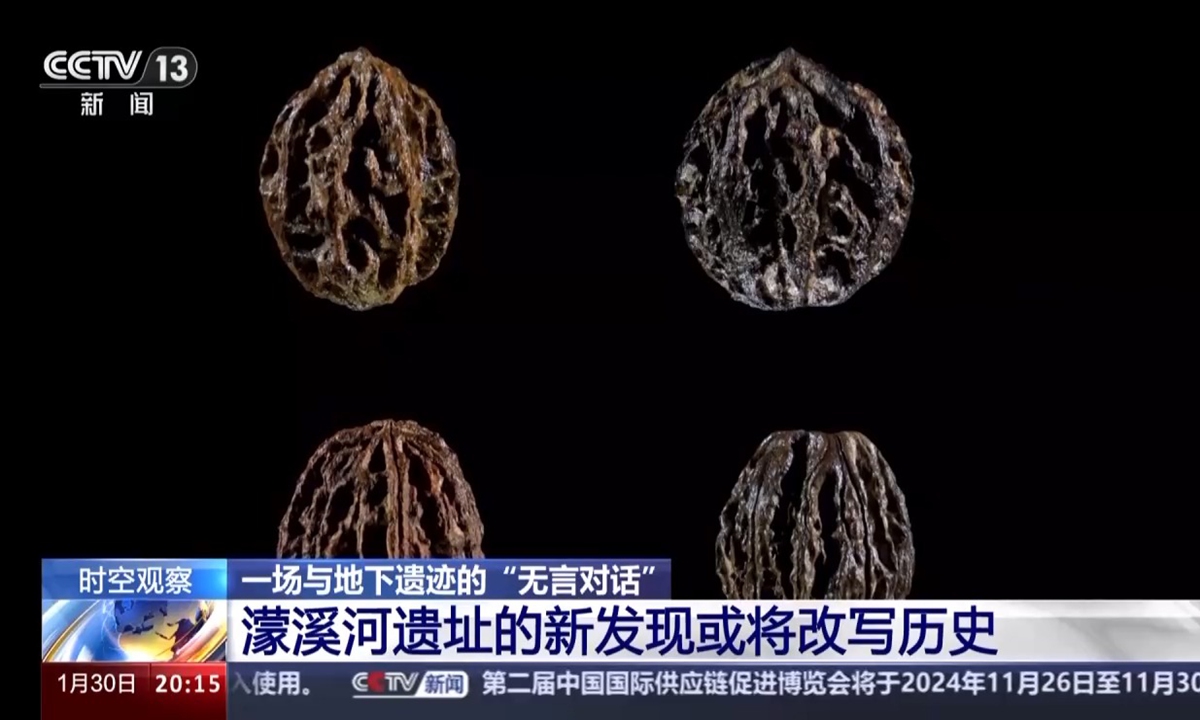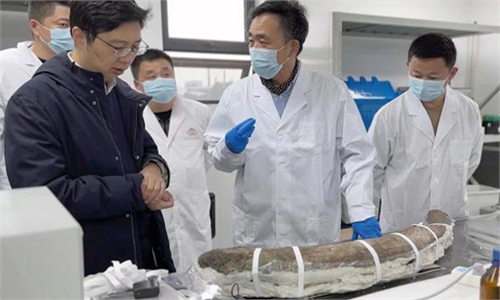ARTS / CULTURE & LEISURE
Human traces and relics dating back 50,000 to 70,000 years found in SW China

Photo: Screenshot from CCTV
More than 105,000 stone tools, wood tools, bone tools and animal fossils, about 60,000 relics including seeds, fruits and spores, alongside traces of fire, cutting, carving and polishing left by ancient humans were found at the Mengxihe Site, dating back 50,000 to 70,000 years in Southwest China's Sichuan Province.
The discovery has been announced as one of the top six archaeological findings of China in 2023 on Tuesday, the Xinhua News Agency reported, citing a statement from the Sichuan Provincial Institute of Cultural Relics and Archaeology.
Located in the city of Ziyang, the site was first found in 2019, when a flood exposed ebony and animal fossils that had been buried underground for tens of thousands of years, said Zheng Zhexuan, an archaeologist at the institute.
A total of 11 interrelated sites along the Mengxi River were found after two years of excavation, forming the Mengxihe Site group.
A preliminary analysis shows that the Mengxihe Site was formed by ancient humans living near the water, and the layer with the greatest cultural significance is located below the current water level of the Mengxi River, which is a special water-saturated burial environment and can retain a lot of organic materials.
In 2023, more than 105,000 stone tools, wood tools, bone tools and animal fossils, as well as 60,000 relics such as seeds, fruits and spores were unearthed. Traces of fire, cutting, carving and polishing left by ancient human behaviors were also found.
Notably, some stones, animal bones, and plants bear artificial carvings, some in the form of "crosses" or "X."
"These markings may be their way of counting and recording events. This discovery is very exciting," said Zheng Zhexuan, an archaeologist at the institute.
Researchers believe that during the Paleolithic era, the gathering and hunting activities of ancient humans were primarily driven by survival needs. However, the non-utilitarian engravings found at the site likely represent an early human exploration of the spiritual world. These markings could be seen as the budding stage of early art or symbolic behaviors in the early stages of human development.
Besides, more than 30 kinds of animal remains, including elephants, rhinoceros, bears, cattle, deer, macaques, fish, turtles, snakes, frogs, birds, porcupines and bamboo rats have been found at the site.
"This collection of animal fossils includes a wide range of sizes and habitats, covering almost all major types of animals including terrestrial, aquatic and aerial, as well as carnivores and herbivores. This indicates a profound understanding of animal resources and diversified hunting capability by ancient humans," Zheng said.
According to Zheng, it is one of the earliest sites in the country where a large number of aquatic animal remains were discovered and among the earliest sites where bird species and the explicit use of carnivorous animals were identified.
In addition, more than 30 families of plant seeds and fruits such as trees, fruits, seeds and gemmae have been found in the remains of plants and walnuts and they are considered the earliest found among all known Paleolithic sites worldwide.
The finds of several Sambucus thunbergiana indicate that ancient humans may have used herbs to treat injuries, Zheng said.
As a result, the findings will reshape the understanding of prehistoric plant utilization, previously believed to have started during the transition from the Paleolithic to the Neolithic era. However, the discovery of a large number of plant remains at the site indicates that ancient humans in this region already had a profound understanding of plant resources, explained Zheng.
Global Times

